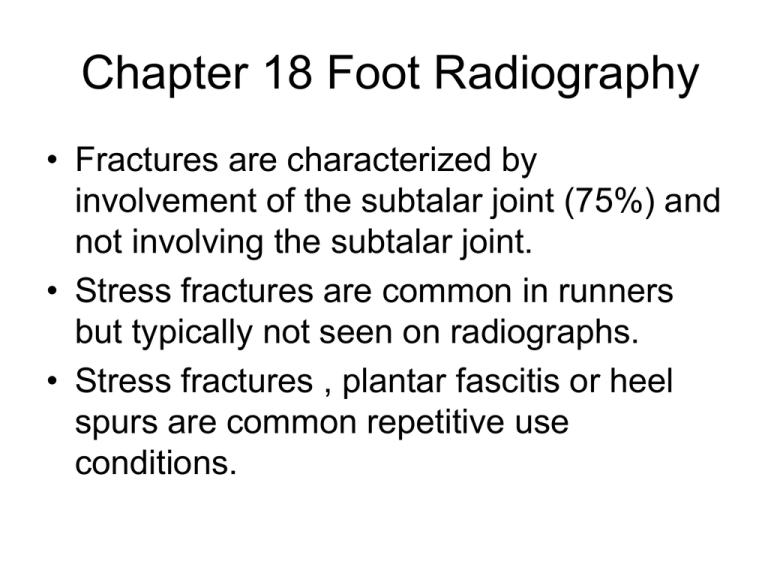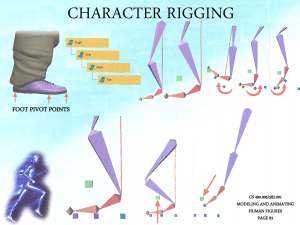Foot A-P
advertisement

Chapter 18 Foot Radiography • Fractures are characterized by involvement of the subtalar joint (75%) and not involving the subtalar joint. • Stress fractures are common in runners but typically not seen on radiographs. • Stress fractures , plantar fascitis or heel spurs are common repetitive use conditions. Foot or Heel Radiography • Views of the foot and calcaneus are totally different. • If a heel injury is suspected, take heel views and not foot views. • A 30 degree medial oblique view can be useful. The oblique and lateral will demonstrate the subtalar joint. Foot Radiography • Foot view must include the tarsal bones, metatarsals and phalanges. • A tube angle is used to open the tarsal bone articulations on the A-P view. • If the patient is flat footed, no tube angle would be needed. Foot Radiography • The medial oblique view is particularly useful. It provides: • A clear view of the tarsal bone including the calcaneus. • The 4th & 5th metatarsals • Intertarsal joints • Detail of the 5th metatarsal Foot Radiography • The “basketball foot” is a traumatic medial subtalar dislocation resulting from landing on an inverted foot. • The “Jones fracture is an avulsion fracture off the base of the 5th metatarsal. • Stress fractures of the metatarsals are generally transverse resulting from marching or jumping. Toe Radiography • Toe radiography can be particularly challenging. • The natural curve of the toes toward the plantar surface of the foot results in foreshortening and closure of the interphalangeal joint spaces. • Besides the A-P, an angled axial view is used to open the joint spaces. 18.4 Foot A-P • Measure: A-P at base of third metatarsal • Protection: Apron • SID: 40” Table Top • Tube Angle: 10° cephalad • Film: 1/2 of 10” x 12 Extremity Cassette I.D. up Foot A-P • Patient seated or lying on table with the long axis of the affected foot centered to table. • Place cassette on table. • Have patient place foot flat on cassette. • Horizontal CR: base of third metatarsal Foot A-P • Vertical CR: long axis of foot. • Collimation Top to Bottom: distal tibia to tips of toes. • Collimation Side to Side: soft tissue of foot • Instructions: Remain still • Make exposure and let patient relax Foot A-P Film • Should demonstrate toes , metatarsals and most of the tarsal bones. The talus and calcaneus will not be seen. • The tube angle will help open the tarsal joint spaces. 18.5Foot Oblique • Measure: A-P at base of third metatarsal • Protection: Apron • SID: 40” Table Top • No Tube Angle • Film: 1/2 of 10” x 12 Extremity Cassette I.D. up Foot Oblique • Patient seated or lying on table with the long axis of the affected foot centered to table. • Place cassette on table. • Have patient place foot flat on cassette. • The foot is medially rotated 30 to 40° • A sponge may be used under the plantar surface of the foot. • Horizontal CR: base of third metatarsal • Vertical CR: long axis of foot. • Collimation Top to Bottom: distal tibia to tips of toes. • Collimation Side to Side: soft tissue of foot • Instructions: Remain still • Make exposure and let patient relax Foot Oblique Foot Oblique Film • Should demonstrate toes , metatarsals and most of the tarsal bones. The talus and calcaneus will not be seen. • The calcaneus will be well visualized • Tarsal joint spaces should be open. 18.6 Foot Lateral • Measure: Lateral at base of first metatarsal • Protection: Lead Apron • SID: 40” Table Top • No Tube Angle • Film: 8” x 10” or 10” x 12” Extremity depending on foot size. Foot Lateral • Patient lies on the affected side with lower leg in lateral position. • The foot should be dorsiflexed until the plantar surface is perpendicular to ankle. • The plantar surface of foot is perpendicular to film. Foot Lateral • The film may be turned diagonally or the foot placed diagonally on film to fit the entire foot on the film. • Horizontal CR: base of 1st metatarsal • Vertical CR: base of first metatarsal Foot Lateral • Collimation Top to Bottom: to include ankle to plantar surface soft tissue • Collimation Side to Side: to include from heel to tips of toes. • Instructions: Remain still • Make exposure and let patient relax. Foot Lateral Film • The foot and ankle should be in a lateral position. • The metatarsals and toes will be superimposed. • The distal fibula should overlie the distal tibia. • The talotibial joint space should be open. 18.7 Toes A-P & Axial A-P • Measure: A-P at 3rd metatarsal phalangeal joint or affected toe • Protection: Lead Apron • SID: 40” Table Top • Tube Angle A-P: none • Tube Angle Axial A-P: 15° cephalad • Film: 1/4 of 10 x 12 Extremity Toes A-P & Axial A-P • A-P : patient places foot flat on film. • Horizontal & Vertical CR: 3rd M-P joint for all toes or M-P joint of the affected toe for individual toe series. • A-P Axial tube angle: same as above but with 15° cephalad angle. Toes A-P & Axial A-P • A-P Axial with Sponge: a 15° sponge is placed under toes instead of angling the tube. Or • The Sponge is placed under the cassette • Horizontal & Vertical CR: 3rd M-P joint for all toes or M-P joint of affected toe. Toes A-P & Axial A-P • Collimation top to bottom: to include all M-P joints to tips of toes or M-P joint to tip of affected toe. • Collimation Side to Side: soft tissue of foot or individual toe. • Instructions: Remain Still • Expose and let patient relax Toes A-P & Axial A-P Film • A-P is upper right image. • A-P Axial is upper left image. The phalangeal joints will be open on the axial view. • Views must include all of the affected toe or toes. • Note that collimation was too tight top to bottom. 18.8 Toes Medial Oblique • Measure: A-P at metatarsalphalangeal joints • Protection: Apron • SID: 40” Table Top • No tube angle • Film: 1/4 of 10” x 12” or 8” x 10” Extremity Cassette Toes Medial Oblique • Patient places distal foot on unexposed portion of cassette. • Patient medially rotates lower leg until the plantar surface forms a 30 to 45° angle. • Horizontal CR: 3rd MTP joint or the affected toe. Toes Medial Oblique • Vertical CR: centered to long axis of foot or the affected toe • Collimation top to bottom: Distal metatarsal to tips of toes or affected toe • Collimation side to side: soft tissue of foot or affected toe. Toes Medial Oblique • Patient instructions: Remain Still • Make exposure and let patient relax. • Note that a sponge may be placed under plantar surface of foot to control angle of view . It will also make it more comfortable for the patient. Toes Medial Oblique • The joint spaces should be open. • The distal metatarsal and tips of the toes should be visualized. 18.8 Toes Lateral • Measure: Lateral across the metatarsalphalangeal joints For individual toe use A-P measurement. • Protection: Apron • SID: 40” Table Top • No tube angle • Film: 1/4 of 10” x 12” or 8” x 10” Extremity Cassette • Patient places distal foot on unexposed portion of cassette. • For 1st through 3rd toes • Patient medially rotates lower leg until the plantar surface forms a 90° angle. • For 4th and 5th toes • Patient laterally rotates foot until the plantar surface is perpendicular to film. 1st Toe Lateral 2nd Toe Lateral • For individual toes, tape and tongue depressors are used to clear the other toes out of the view. • Without the use of tape and tongue depressors, there will be too much superimposition • Horizontal CR: 3rd MTP joint or the affected toe. • Vertical CR: centered to long axis of foot or the affected toe • Collimation top to bottom: Distal metatarsal to tips of toes or affected toe • Collimation side to side: soft tissue of foot or affected toe. 3rd Toe Lateral 4th Toe Lateral • Patient instructions: Remain Still • Make exposure and let patient relax. • Note that the lateral surface of the foot is next to the film. 5th Toe Lateral • Note that the lateral surface of the foot is next to the film. • The toe need to remain parallel to the film. • The 5th toe is the most challenging lateral toe view. Toes Lateral Film • The joint spaces should be open. • The distal metatarsal and tips of the toes should be visualized. • The affected toe should be free of superimposition. Accessory Testing • Accessories include the cassettes, grids outside the Bucky, Lead Aprons and gonadal protection. • The cassettes and screens are the primary concern. • Screens should be cleaned monthly with screen cleaner. Keeping the darkroom clean is also important for screen cleanliness. 23.4 Screen Contact Testing • Procedure: • Clean screens and let them dry. Use screen cleaner design for the screen used. • With a felt tip pen, write an identification number on the screen next to the I.D. and on the back of the cassette. • Load cassettes. Screen Contact Testing • • • • Procedure: Set SID to 40” Table Top Place cassette on table. Place wire mesh tool on cassette. • Set collimation to film size. • Make exposure and process film. Screen Contact Testing • Procedure: • Hang film on view box. • Step back 72” from view box and view film. • Areas of increased density or loss of resolution indicates poor contact or stained screens. Screen Contact Testing • Procedure: • The I.D. # will help you find a cassette that needs to be cleaned or taken from service. • Frequency of tests: semiannual • Poor Screen Contact There is a loss of detail in the thoracic and lumbar spine due to poor screen contact. • This was a new cassette. • Poor Screen Contact Note the blurry image in the spine but sharp image of the ribs. • The screens were not in proper contact in the middle of the cassette due to a bow in the cassette back. Screen Cleaning • Materials needed: • Screen Cleaner designed for type of screens used. • 4 x 4 gauze or cotton balls • Tape & Pen Screen Cleaning • Procedure: • Unload cassette if contact is not being tested. • Apply cleaner with gauze. • Wipe excess off with dry gauze. Screen Cleaning • Leave open to air dry. • Make sure cassette # is still legible. • After dry, reload cassette. Screen Cleaning • Record date on tape and place on back of cassette. • By having each cassette identified, selected cassette can be cleaned as needed. Screen Cleaning • California Department of Radiologic Health recommends cleaning screens monthly. • Should definitely be done quarterly and sooner as needed when artifacts are identified on films. • Never use alcohol or detergents not designed for cleaning screens. Cassette Care • Methods to get the maximum life from cassettes: – Avoid dropping the cassettes – Open only far enough the change films – Keep outside of cassette clean and dry. – Keep screens clean – Store on end. Dirty or Damaged Screens • Dirty or damaged screen will cause white spots on the image. Dirty & Damaged Screens • The white spots on this film are the result of damaged or worn out screens. • Never use alcohol or detergents to clean screens. Speed Matching • After looking for screen contact problems: • Measure speed of cassettes by reading density with the Densitometer. The density of the exposed area should not vary more than ± 0.05 OD. • As screen age, they loose speed. • Always make sure the light spectrum of the screens and film are matched. 23.5 Apron and Gonad Shield Testing • Lead aprons and shields should be tested semiannually for defects • Aprons with defective lead provide little protection for the patient. Apron and Gonad Shield Testing • Tools needed: – 14” x 17” cassette – View Box • Coat Apron Procedure: • Drape apron over Bucky • Place cassette in Bucky make exposures in upper and lower Bucky slots. Apron and Gonad Shield Testing • Coat Apron Procedure: • Note that this is the same test as used for grid alignment. • Process films • View films on view box: Apron and Gonad Shield Testing • Half Apron and Small Shield Procedure: • Place cassette on table • Set SID at 40” • Place apron or shields on cassette. • Make exposure and process the film. Apron and Gonad Shield Testing • Viewing the test films: – Note creases in the lead. – Full holes will produce a black area on the film. – If cracks or defects are in the area that should cover the gonads, replace apron. Care of Aprons • Never fold aprons • Store flat or hung on apron rack • Use only aprons with the lead equivalency of 0.5mm for patient and staff protection. • Do not use as lead blockers for extremity films. • Protect from heat and direct sun light. Grid Uniformity Testing • Procedure is the same as testing the Bucky Grid. • Place homogenous phantom or lead apron over grid that is taped to the top of the cassette. • Make exposure and look for density changes and grid damage.







